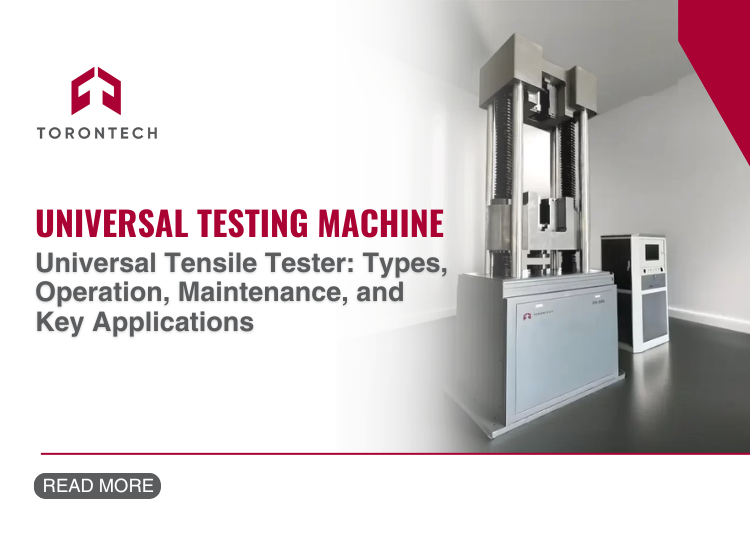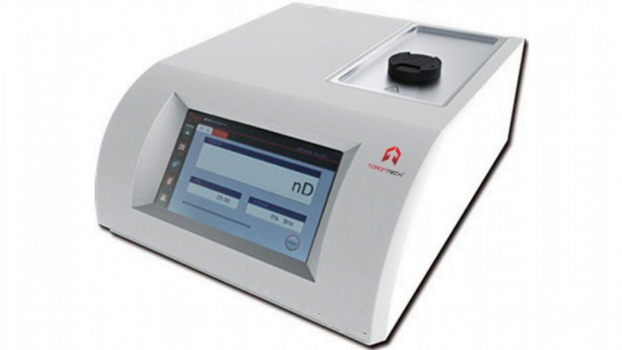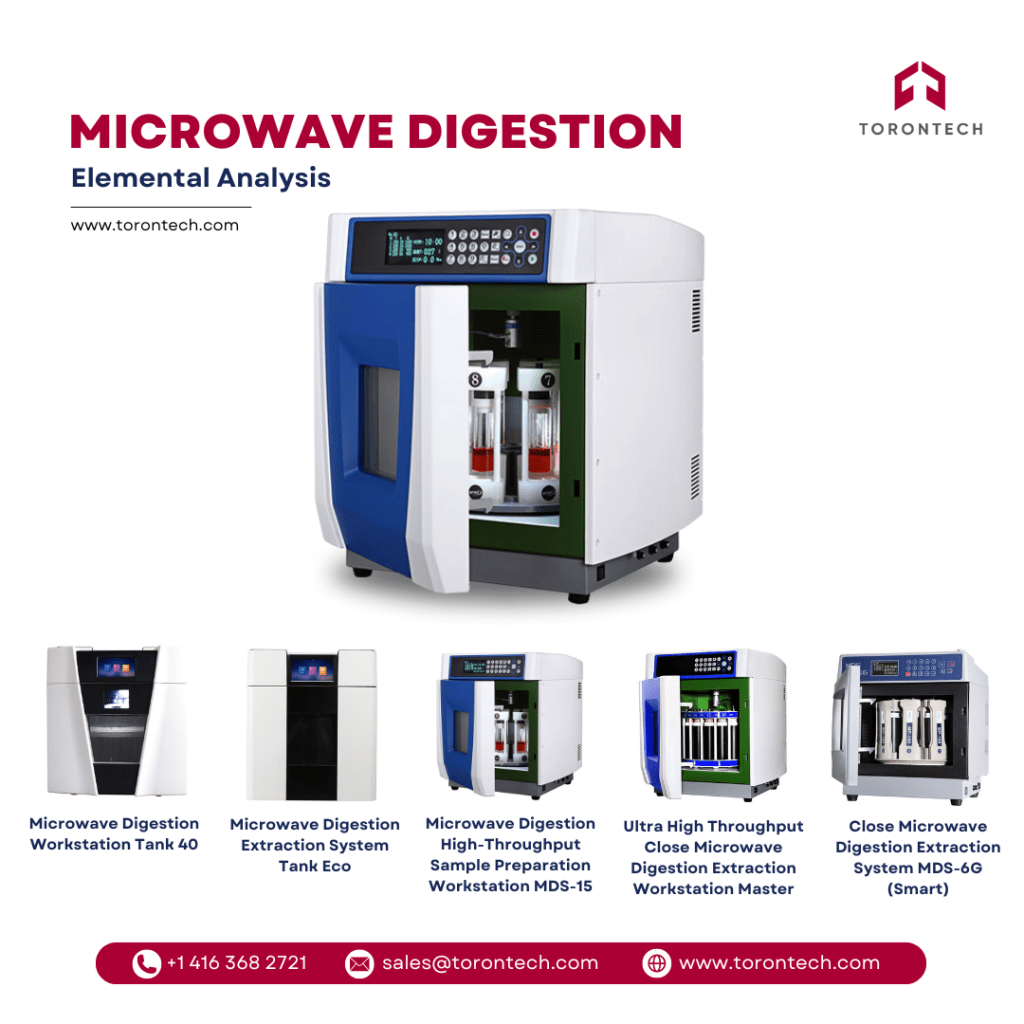Inconsistent test results, machine breakdowns, or incorrect setups can cost you time and resources when working with a Universal Tensile Tester also known as Universal Testing Machine (UTM). These issues often come down to choosing the right machine, proper handling, or neglected maintenance.
This guide will walk you through the types of UTMs available, practical steps for operation, and essential maintenance tips. With these insights, you can prevent common problems and get accurate, repeatable test results for your material testing projects.
Types of Universal Testing Machines
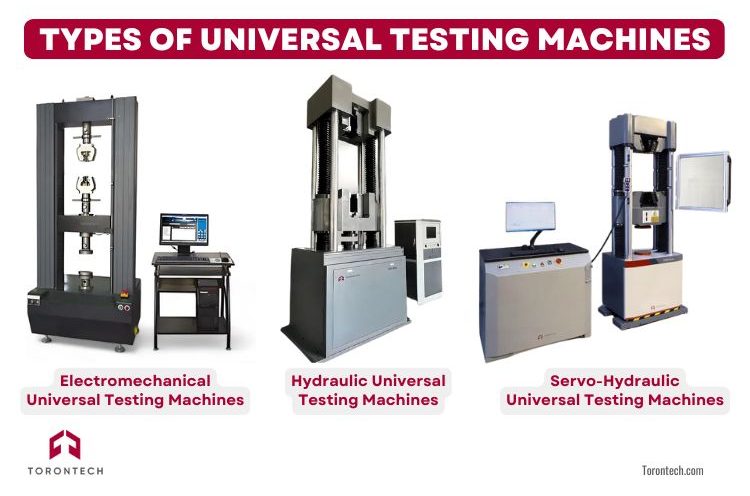
Selecting the right UTM Machine or Universal Tensile Tester is crucial for achieving accurate and reliable material testing results. Different types of UTMs are designed to handle various materials, force ranges, and testing requirements. Understanding their differences helps you choose a machine that best suits your needs.
1. Electromechanical Universal Testing Machines
Electromechanical UTMs are widely used for their precision and flexibility. They operate using a servo motor and ball screw drive, allowing for fine control over force application. These machines are ideal for:
- Low to medium force testing (plastics, rubbers, textiles, and biomaterials).
- Applications requiring high-precision speed control and repeatability.
- Tensile, compression, flexural, and shear testing in research and quality control laboratories.
Electromechanical models typically come in single-column and dual-column designs. Single-column UTMs are compact and best suited for lower-force applications, while dual-column models offer greater stability for higher loads.
2. Hydraulic Universal Testing Machines
For high-force applications, hydraulic UTMs are the preferred choice. These machines use fluid pressure to generate force, making them ideal for testing metals, concrete, and composites. Hydraulic UTMs are commonly found in industries that require:
- Heavy-duty material testing with forces exceeding 300 kN to 1,000 kN or more.
- Structural steel, aerospace components, and civil engineering materials.
- Long-term durability tests where high loads are applied over extended periods.
Although hydraulic systems are powerful, they require regular maintenance due to oil-based components that need monitoring and servicing.
3. Servo-Hydraulic Universal Testing Machines
A combination of hydraulic power and servo-controlled precision, servo-hydraulic UTMs offer greater accuracy than conventional hydraulic models. They are commonly used for:
- Fatigue testing and high-cycle load applications.
- Dynamic and impact testing, such as simulating real-world stress conditions.
- Testing materials under variable speed and load conditions.
These machines provide better control over load application but come at a higher cost compared to standard hydraulic UTMs.
Choosing the Right UTM for Your Needs
When selecting a Universal Testing Machine, consider the following factors:
- Material Type – Softer materials (plastics, rubber) suit electromechanical UTMs, while rigid materials (metals, composites) require hydraulic or servo-hydraulic machines.
- Load Capacity – Determine whether you need a low-capacity machine (up to 50 kN) or a high-force system (300 kN and above).
- Testing Speed & Accuracy – Electromechanical UTMs provide finer control, while hydraulic machines excel at handling high loads.
- Software & Automation – Modern UTMs integrate with advanced software such as Non-Contact Video Extensometer for automated data collection and analysis.
Understanding these UTM types ensures that you invest in the right system for your material testing applications.
How to Operate a Universal Tensile Tester
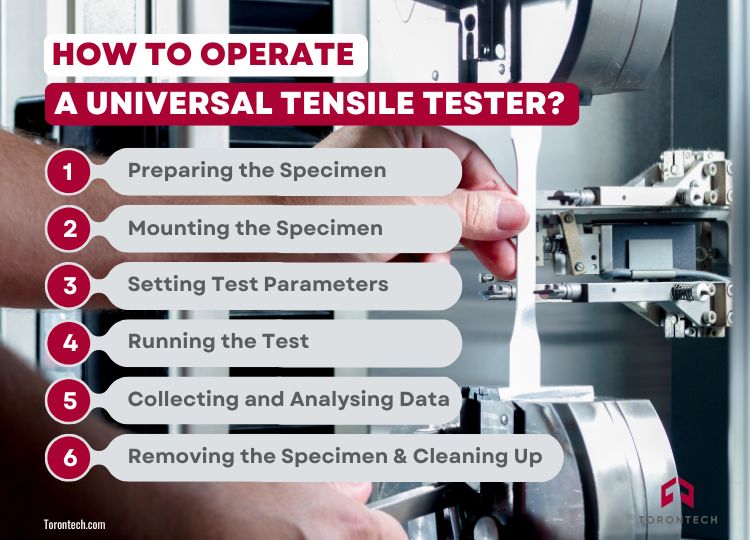
Operating a Universal Tensile Tester correctly is essential for obtaining accurate, repeatable, and reliable test results. Below is a step-by-step guide to operating a UTM properly.
1. Preparing the Specimen
Before starting a test, you need to prepare the material sample according to the relevant standards (ASTM, ISO, or other applicable regulations). Proper preparation prevents inaccurate results due to misalignment or irregularities in the specimen.
- Ensure correct dimensions – Cut or shape the specimen according to test requirements.
- Check surface condition – Avoid rough edges or uneven surfaces that may affect grip.
- Mark measurement points – Some tests require gauge markings for strain measurement.
2. Mounting the Specimen
Once the sample is ready, it needs to be securely mounted between the grips or fixtures to prevent slippage or misalignment.
- For tensile tests – The specimen is clamped between the upper and lower grips, ensuring even distribution of force.
- For compression tests – The sample is placed between two platens to apply pressure evenly.
- For flexural tests – The material is positioned on a bending fixture with two support points.
3. Setting Test Parameters
Once the specimen is mounted, you need to configure the UTM software to set test parameters such as:
- Test Type – Select tensile, compression, bending, shear, or another test method.
- Load Rate & Speed – Define the rate at which force will be applied to the specimen.
- Displacement & Strain Measurement – Enable extensometers or strain gauges if needed.
- Failure Criteria – Set stopping conditions (e.g., breakage, deformation limit).
Modern UTMs come with automated software, allowing pre-programmed test procedures for faster and more consistent results.
4. Running the Test
With the parameters set, you can now start the test:
- Press the start button – The crosshead moves to apply force according to the test settings.
- Monitor real-time data – The software records force, displacement, and strain values.
- Observe specimen behavior – Watch for signs of material deformation, yielding, or fracture.
- Test completion – The test stops automatically based on the set failure criteria or when the operator ends it manually.
For tensile tests, the specimen elongates until it fractures.
For compression tests, the material deforms under pressure.
For flexural tests, bending stress is applied until failure or a predefined limit.
5. Collecting and Analysing Data
After the test, the UTM software generates results, including:
- Force vs. Displacement Graphs – Shows how the material responded to applied force.
- Stress-Strain Curves – Helps determine yield strength, elastic modulus, and failure points.
- Test Reports – Exportable reports with key mechanical properties for documentation and analysis.
6. Removing the Specimen & Cleaning Up
Once the test is complete:
- Release grips carefully – Avoid sudden release, especially for fragile specimens.
- Inspect the sample – Check for failure mode (brittle, ductile, shear, etc.).
- Clean the test area – Remove debris and ensure the grips are ready for the next test.
Regularly maintaining a clean and organised workspace improves testing efficiency and equipment lifespan.
How to Maintain a Universal Testing Machine
A UTM Machine is a critical investment for any laboratory or production facility. Regular maintenance ensures accuracy, extends the lifespan of the machine, and prevents unexpected failures. Neglecting maintenance can lead to inaccurate results, costly downtime, and even equipment damage.
1. Routine Cleaning and Inspection
Keeping the UTM clean is a simple but crucial step in maintaining its accuracy. Dust, debris, and residue from tested materials can accumulate and affect performance.
- Clean the grips and fixtures – Remove any debris or test residue using a soft brush or compressed air.
- Wipe down the load frame – Use a lint-free cloth and mild cleaner to remove dust and contaminants.
- Check for loose parts – Inspect bolts, screws, and fasteners for any signs of wear or loosening.
- Inspect cables and connections – Ensure all electronic connections are secure and undamaged.
Regular cleaning helps prevent minor issues from escalating into serious mechanical failures.
2. Lubrication and Mechanical Maintenance
Proper lubrication reduces friction and wear on moving components, ensuring smooth operation.
- Lubricate the lead screws and ball screws – Use manufacturer-recommended lubricants to prevent stiffness and uneven movement.
- Check hydraulic fluid levels (for hydraulic UTMs) – Ensure the fluid is clean and free from contamination.
- Inspect seals and hoses – Look for leaks or cracks in hydraulic components.
- Monitor crosshead movement – The crosshead should move smoothly without unusual resistance or noise.
Neglecting lubrication can cause excessive wear on mechanical parts, leading to costly repairs.
3. Calibration and Verification
Calibration is essential for ensuring the accuracy of force, displacement, and strain measurements. Over time, sensors and load cells may drift, leading to incorrect test results.
- Verify load cell accuracy – Perform regular force calibration using certified weights.
- Check displacement measurement – Ensure the extensometer and crosshead displacement sensors are providing correct readings.
- Run software validation tests – Confirm that the test software records and processes data accurately.
- Schedule professional calibration – Follow the manufacturer’s recommendations for periodic third-party calibration.
Accurate calibration ensures compliance with ASTM, ISO, and other international testing standards.
4. Software and System Updates
Modern UTMs rely on software for test execution, data collection, and analysis. Keeping the software up to date ensures compatibility with the latest testing methods and improves functionality.
- Update UTM software regularly – Install manufacturer-released updates to fix bugs and enhance features.
- Back up test data – Store results on an external drive or cloud storage to prevent data loss.
- Ensure correct sensor integration – If upgrading software, verify that all sensors and attachments function properly.
Regular updates help maintain system efficiency and prevent software-related disruptions.
5. Troubleshooting Common Issues
Even with regular maintenance, UTMs may develop minor issues. Identifying and addressing them early prevents major failures. Common Problems and Solutions:
| Issue | Possible Cause | Solution |
| Load readings are inconsistent | Load cell calibration drift | Recalibrate the load cell |
| Specimen slipping in grips | Worn or incorrect grips | Replace or use appropriate grips |
| Noise or vibration during testing | Loose fasteners or dry components | Tighten bolts and apply lubrication |
| Software not responding | Outdated software or driver issues | Update software and check connections |
If a problem persists, contacting the manufacturer’s support team or referring to the user manual is recommended.
Applications of Universal Testing Machines
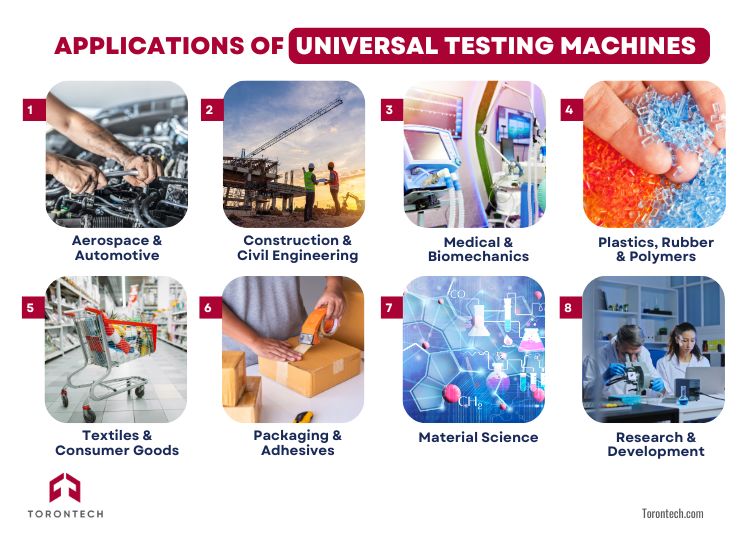
Universal Testing Machines play a key role in material testing, ensuring products meet performance and safety standards across industries. They evaluate tensile strength, compression resistance, and durability for various applications.
1. Aerospace & Automotive
UTMs assess the strength, fatigue resistance, and impact durability of metals and composites used in aircraft and vehicles. These tests ensure that structural components, adhesives, and protective coatings withstand extreme conditions, improving safety and performance.
2. Construction & Civil Engineering
Building materials like concrete, steel, and composites undergo UTM testing to verify load-bearing capacity, tensile strength, and flexural properties. These tests help engineers design safer and more durable infrastructure, ensuring compliance with industry regulations.
3. Medical & Biomechanics
Medical devices, implants, and biomaterials require tensile, compression, and flexibility testing to ensure safety and long-term performance. UTMs evaluate the durability of prosthetics, synthetic bones, and medical textiles, preventing failures in critical healthcare applications.
4. Plastics, Rubber & Polymers
UTMs test elasticity, puncture resistance, and tensile properties in plastic films, rubber components, and polymers. These tests are crucial for ensuring durability and flexibility in applications like automotive interiors, industrial materials, and packaging.
5. Textiles & Consumer Goods
Textile manufacturers use UTMs to measure fabric strength, seam durability, and tear resistance in clothing, footwear, and protective gear. Adhesion testing ensures glued or bonded materials maintain their structural integrity over time.
6. Packaging & Adhesives
UTMs validate peel strength, seal integrity, and puncture resistance of packaging materials. Compression tests on cartons and containers help ensure they can withstand stacking pressure and prevent damage during transportation and storage.
7. Material Science
Material scientists use UTMs to study mechanical properties, failure modes, and stress-strain behavior of new and existing materials. These insights drive innovation in advanced materials, helping industries develop stronger, lighter, and more durable products.
8. Research & Development
UTMs support R&D efforts by providing precise data on material performance under controlled conditions. Engineers and researchers use these machines to test new formulations, optimize product designs, and ensure compliance with industry standards before mass production.
Final Thoughts
Selecting the right Universal Testing Machine is important for achieving accurate and consistent test results. With various models available, factors such as test type, load capacity, and automation level must be carefully considered. Investing in the right equipment ensures compliance with industry standards, reliable data collection, and long-term efficiency in material testing.
If you need assistance in choosing the best UTM for your application, don’t hesitate to reach out. Our dedicated team can guide you through the selection process. To discover our extensive range of Universal Testing Machines, visit this.

